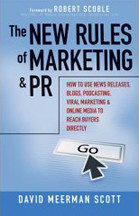One of the most significant changes in news reporting and public relations was somewhat missed by the general public. PR Newswire, the global leader in news and information distribution services for professional communicators, did what most public relations professionals seemed unwilling to do just a few months ago: embrace social media.
Releases sent over this popular wire service have been employing social media elements inspired by SHIFT Communications (just a bit more streamlined), include RSS feeds, Technorati and Digg links. The benefit is this news distribution model makes it even easier for social media to select stories that interest them, just as mainstream media outlets have done for years.
There is still some room for improvement — the "blogs discussing this news release" is linked to a headline search instead of combined keywords — but these are minor issues that will eventually be modified. The change is admirable and a badly needed first step that levels the playing field (even if it is somewhat responsive to some bloggers suggesting they can create online public relations distribution platforms too).
There also seem to be a few side effects that are becoming more noticeable and pervasive: the quality of the news releases from a journalistic perspective are being buried with colorful leads, non-news, and increased puffery. It's the kind of stuff some bloggers might grab up because they don't have to rewrite it.
But for a journalist, it can be a bit maddening at times to look for buried news while trying to beat the deadline and field calls from public relations specialists asking if the release they sent was received. Here are a few random leads from releases distributed by PR Newswire today:
"Hiring an ad agency can be a scary thought. I mean who wants to deal with those egos? Or even scarier, who wants to see that agency invoice?"
"To a room filled with close to 200 advertisers and media, the 2007 GolTV Upfront got off to a great start."
"Canada, the world's second largest country and number one "foreign" destination for Americans, is tired of hearing that it's too nice, too pretty, too pristine and too safe, let alone too similar to the U.S.A."
I'm not saying any of these leads are "good" or "bad" as much as I'm saying this is what is — new releases are trending to be much more editorialized and I'm not so sure that's a good thing. Worse, in some cases, companies might even be tempted to release padded news, knowing that citizen journalists (some mainstream journalists too) are a bit lax on fact checking.
Personally, I think a crisp news release is still the better communication tool. It's more credible and can be picked up just as easily by members of the social or mainstream media. It also makes me wonder what the future might look like if more and more companies turn toward editorial releases instead of solid news. Hmmm... the word wacky comes to mind.

Releases sent over this popular wire service have been employing social media elements inspired by SHIFT Communications (just a bit more streamlined), include RSS feeds, Technorati and Digg links. The benefit is this news distribution model makes it even easier for social media to select stories that interest them, just as mainstream media outlets have done for years.
There is still some room for improvement — the "blogs discussing this news release" is linked to a headline search instead of combined keywords — but these are minor issues that will eventually be modified. The change is admirable and a badly needed first step that levels the playing field (even if it is somewhat responsive to some bloggers suggesting they can create online public relations distribution platforms too).
There also seem to be a few side effects that are becoming more noticeable and pervasive: the quality of the news releases from a journalistic perspective are being buried with colorful leads, non-news, and increased puffery. It's the kind of stuff some bloggers might grab up because they don't have to rewrite it.
But for a journalist, it can be a bit maddening at times to look for buried news while trying to beat the deadline and field calls from public relations specialists asking if the release they sent was received. Here are a few random leads from releases distributed by PR Newswire today:
"Hiring an ad agency can be a scary thought. I mean who wants to deal with those egos? Or even scarier, who wants to see that agency invoice?"
"To a room filled with close to 200 advertisers and media, the 2007 GolTV Upfront got off to a great start."
"Canada, the world's second largest country and number one "foreign" destination for Americans, is tired of hearing that it's too nice, too pretty, too pristine and too safe, let alone too similar to the U.S.A."
I'm not saying any of these leads are "good" or "bad" as much as I'm saying this is what is — new releases are trending to be much more editorialized and I'm not so sure that's a good thing. Worse, in some cases, companies might even be tempted to release padded news, knowing that citizen journalists (some mainstream journalists too) are a bit lax on fact checking.
Personally, I think a crisp news release is still the better communication tool. It's more credible and can be picked up just as easily by members of the social or mainstream media. It also makes me wonder what the future might look like if more and more companies turn toward editorial releases instead of solid news. Hmmm... the word wacky comes to mind.



















